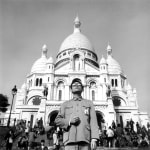

Tseng Kwong Chi American, 1950-1990
Paris, France (Sacre Coeur), 1983
Silver gelatin print
91.44 x 91.44 cm; (36 x 36 in.)
Edition of 9 + 2 AP (#2/9)
Tseng Kwong Chi arrived on the downtown art scene of New York City in the late 1970s, where his circle included Keith Haring, Kenny Scharf and Jean-Michel Basquiat. Tseng’s artistic...
Tseng Kwong Chi arrived on the downtown art scene of New York City in the late 1970s, where his circle included Keith Haring, Kenny Scharf and Jean-Michel Basquiat. Tseng’s artistic identity was born when he arrived at the upscale touristic restaurant Windows on the World in the World Trade Towers to dine with his visiting parents wearing a Mao suit he had picked up at a thrift shop. While his parents were dismayed—his father had served in the Nationalist Army—the maître d’ treated him as a foreign dignitary all evening. From that moment on, the young artist assumed the identity of an ambiguous Chinese statesman, appearing at exclusive events and international landmarks, solemnly posing in his Mao costume and ID badge, with reflective sunglasses and an army-style haircut. The performance played on Western assumptions and clichés about Asian identity.
Taken in front of the Sacré-Cœur in Paris, Paris, France (Sacré-Cœur), 1983, is part of Tseng’s East Meets West series. In this image, the artist presents himself in the formal pose typical of the project, confronting the viewer and the monument with equal detachment. Tseng had previously studied art and photography at the Académie Julian in Paris, and the city held a personal significance within his broader exploration of cultural identity and place. The use of iconic tourist destinations, such as Sacré-Cœur, became a way for Tseng to critique both the construction of national identity and the role of the artist as observer.
Taken in front of the Sacré-Cœur in Paris, Paris, France (Sacré-Cœur), 1983, is part of Tseng’s East Meets West series. In this image, the artist presents himself in the formal pose typical of the project, confronting the viewer and the monument with equal detachment. Tseng had previously studied art and photography at the Académie Julian in Paris, and the city held a personal significance within his broader exploration of cultural identity and place. The use of iconic tourist destinations, such as Sacré-Cœur, became a way for Tseng to critique both the construction of national identity and the role of the artist as observer.
16
of
16

